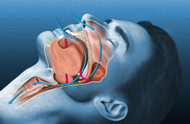Can Dentists Treat Obstructive Sleep Apnea?
Posted by Dental Didactics CE: Dental Board of California Registered CE Provider #RP3768, Academy of General Dentistry National PACE Provider #217643 on Oct 1st 2022
Widespread Diagnosis of Sleep Apnea
Obstructive Sleep Apnea is a widespread diagnosis in the general population and has reached epidemic levels world-wide. It is a sleep disorder which presents nocturnally in which the patient has their breathing repeatedly stop and start. Patients at risk are those who have symptoms of loud snoring and feelings of fatigue despite getting a full night's sleep. Overweight patients with large fluctuant tissues masses at the rear of their mouths are more prone to suffering obstructive sleep apnea. When throat musculature relaxes at night the excess tissue falls back to block the patient's airway.
Warning Signs of Sleep Apnea:
Dentists screen patients for obstructive sleep apnea and watch for the following signs and symptoms:
- History of loud snoring
- Daytime fatigue and sleepiness
- Documented cessation of breathing/gasping for air during sleep
- Nighttime sudden awakenings related to choking or gasping for air
- Dry mouth and sore throat upon awakening
- Headache upon awakening
- Poor focus, fatigue, lack of concentration during the day
- Falling asleep during the day or at inappropriate times
- More common in overweight patients
- Prevalence in men
How Do Dentists Treat Obstructive Sleep Apnea?
Dentists will order a formal sleep study to diagnosis obstructive sleep apnea, and recommend lifestyle changes such as weight loss, minimizing alcohol consumption, smoking cessation, use of nasal decongestants, and min imizing the use of sleeping medication to minimize the relaxation of soft tissue masses at the back of the mouth. Sleep position can be altered (raising the head of the bed) and use of a Continuous Positive Airway Pressure (CPAP) device in conjunction with a physician may be ordered.
Dentists specifically, may fabricate oral devices worn by patients at night that assist airway opening much like the head tilt in cardio-pulmonary resuscitation (CPR). The devices consist of an up and lower arch horseshoe-type appliance which interconnect and help keep the patient's airway open during the night.
For more information see our Dental CE course on Obstructive Sleep Apnea

